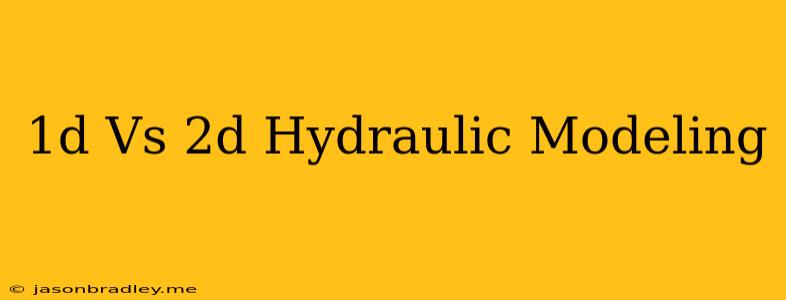1D vs 2D Hydraulic Modeling: A Comparison
Hydraulic modeling is a crucial tool for understanding and predicting the behavior of water in various systems, from rivers and canals to urban drainage networks. Two common approaches to hydraulic modeling are 1D and 2D modeling. Each approach has its own strengths and limitations, making them suitable for different applications.
1D Hydraulic Modeling
1D models simplify the flow by considering water movement in only one dimension, typically along the flow path (e.g., the length of a river). These models are based on the Saint-Venant equations, which describe the conservation of mass and momentum for unsteady flow.
Advantages:
- Simple and computationally efficient: 1D models are relatively straightforward to develop and execute, requiring less computational power and data compared to 2D models.
- Suitable for large-scale systems: They are well-suited for analyzing flow in long, narrow channels, such as rivers and canals.
- Effective for preliminary assessments: 1D models can provide a quick and efficient overview of system behavior, identifying potential issues and guiding further investigation.
Limitations:
- Oversimplification of flow patterns: 1D models neglect lateral flow and cross-sectional variations, which can be significant in some cases.
- Limited accuracy for complex geometries: They may struggle to accurately represent flow in areas with intricate geometries, such as urban drainage networks.
- Inaccurate predictions for non-uniform flow: 1D models are less reliable for flow scenarios with strong lateral gradients or non-uniform velocity profiles.
2D Hydraulic Modeling
2D models represent flow in two dimensions, typically along a horizontal plane. They capture the spatial variation of flow depth, velocity, and pressure across the modeled area.
Advantages:
- Improved accuracy for complex geometries: 2D models can accurately capture flow patterns in areas with complex shapes and obstructions, such as urban areas and floodplains.
- Realistic representation of flow patterns: They can accurately model lateral flow, inundation, and flow separation, providing a more detailed understanding of flow dynamics.
- Suitable for detailed investigations: 2D models are essential for in-depth analysis of specific areas and scenarios, such as flood risk assessment and urban drainage design.
Limitations:
- Higher computational demand: 2D models require more computational power and data, leading to longer execution times and potentially higher costs.
- Data availability and quality: Accurate 2D modeling requires detailed topographical and bathymetric data, which may not be readily available or of sufficient quality.
- Complexity in model setup and interpretation: Setting up and interpreting 2D models can be more challenging due to their increased complexity.
Choosing the Right Approach
The choice between 1D and 2D hydraulic modeling depends on the specific application, the desired level of detail, and the available resources.
Here are some factors to consider:
- Scale and complexity of the system: 1D models are suitable for large-scale systems with relatively simple geometries, while 2D models are better for smaller, more complex areas.
- Required level of detail: If detailed flow patterns and inundation are essential, 2D modeling is preferable. For preliminary assessments or large-scale systems, 1D modeling may suffice.
- Data availability and computational resources: 2D models require more data and computational power, so consider the availability of these resources before making a decision.
Ultimately, the optimal approach is one that balances accuracy, efficiency, and available resources to meet the specific requirements of the project.
